|
fashion: feature
 Nom D's Margi Robertson: a force to be reckoned with Nom D's Margi Robertson: a force to be reckoned with
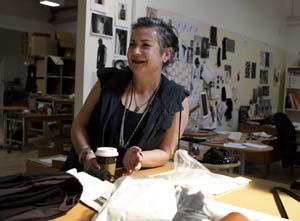
Probably one of the most in-depth Q&As
ever with Nom*D’s Margi Robertson. Questions by Sam Mitchell
photographed by Douglas
Rimington
From issue 25 of
Lucire
In my first year at design school in our pattern-making room
there was an image cut from a magazine of you and your sister Elisabeth
with the word God underneath in huge bold writing. I looked
at that every day, and wholeheartedly agreed. As a woman of foreign
background, functioning out of a relatively small city, how does
it feel to have become such an icon for others in the industry?
Thatís so funny because on the other side of the magazine was the
word mothers, which was how we were described in the industry.
Not exactly "iconic", but a title that that denoted respect
which was quite humbling. For me it was incredibly rewarding, too.
For Chris and me, we have always loved living in Dunedin and the
temptation to move to Auckland to further enhance our label in the
market was never an option. There is no other city in New Zealand
that can boast the history of Dunedin, its importance in early New
Zealand, and its underground feel, itís very free of pressures and
influences that can often prove to be very superficial in other
cities in New Zealand.
How did Nom*D begin and grow, and at what point in your career
did you realize that youíd become a force to be reckoned with within
New Zealand fashion?
We fell into designing and manufacturing by accident. We started
retailing in an environment that didnít really have the presence
of specialized boutiques, so we had quite a small shop with labels
that pretty much came from Auckland, but did not fall in the “mass-produced”
category. One particular knitwear label that we stocked for a couple
of years decided to make the move from “boutique” to a
little more mainstream. As Liz, my sister from Zambesi had started
doing her own label, we thought knitwear would be a great complement
to Zambesi in our stores; we had Roslyn Knitting Mills over the
hill, and a well established knitting manufacturing plant in Kaikorai
Valley. It seemed perfect for us, and we wouldnít have to leave
town!
However, unfortunately, the mill closed down and
the knitters didnít really appreciate the Nom*D style or philosophy
so we did start having the garments made outside of Dunedin. We
were fortunate that via our already established retail store, we
had lots of contact with other retailers throughout New Zealand,
so we pretty much started out wholesaling immediately both in New
Zealand and Australia. I donít know whether we were a Ďforce to
be reckoned withí but we had a nice business creating and producing
garments that seemed to attract quite discerning fashionistas. We
have been wholesaling and retailing our garments since then with
the encouragement of great feedback from both the industry and consumers.
As anyone in the industry knows, you come from an incredibly
talented family, so is there anything in particular about your childhood
or growing up that inspired you to become a designer?
It would have to be the encouragement from our mother who was a
machinist from her youth. She always worked in the industry here
in Dunedin, from Menswear Suitmakers, to Sew Hoys and Hallensteinís.
The sewing machine did not really ever get put awayóin fact it was
often in the loungeóso you could watch TV
at the same time as making up your “Saturday night” outfit.
Mum encouraged us to customize patterns so the creativity would
have started there, and never stopped really.
We always had lots of fashion magazines around,
mostly ones with patterns though, like Burda (German) or
Dressmaking (Japanese): they always had patterns you could
trace out. And knitting patterns, too, and she always had a huge
chest of fabric ends, mostly bought from Penroses, who constantly
had “remnants” on offer. They were often left-over fabric
from manufacturers so nice handle and quality also became important.
So I guess we always had an appreciation of nice
clothes, good fabric, and an awareness of fashion via the magazines
that Mum bought. We were a large family so if by any chance there
was a “store-bought” purchase for any of us it was a big
deal. Mum usually frequented sales, but we got the most amazing
stuff. My most vivid memory was a collarless coat, with big box
pleats from the hip and a removable scarf that had pom-poms on the
ends. It was red, and I canít remember whether it was my older or
younger sister that also had one. We often had matching outfits,
even with the garments Mum made; our style became more individual
when we could make our own choices and pay for our own clothes.
Does having the the creative family network and peer support
as a result of it that you do contribute to how you work and the
outcome of your designs?
I cannot deny that having my sister Liz at Zambesi in Auckland is
one very handy connection. We are each otherís best wholesale customers
and in the early days when we just made knitwear we did collaborate
on colours, etc. I did travel with Liz when she chose fabrics from
Japan so I had a pretty good idea of where things were going and
we worked together a lot. Once we decided to include woven garments
in the Nom*D collection however, we tended to keep things pretty
close to our chests; often, we do like the same things so we didnít
want to be influenced or put off by what Zambesi were producing.
Since those days, we have remained quite separate in our creative
spaces, and working on our own has really pushed Nom*D forward as
a stand-alone brand. A lot of talk about us flying on the coattails
of Zambesi has definitely been dispelled. We feel very proud of
what we have achieved.
My other siblings are all really talented, although
none work in the fashion industry. My younger sister Vera did work
for both ourselves and Liz in retail, but has never been part of
the design team. She does, however, have her own interior design
business, which is quite unique in its style. Another sister works
in finance in London and my brother has his own IT
business. Both of them work as hard as any of us, and have achieved
great success in their chosen careers, but totally outside of fashion!
Were you faced with any difficulties when founding yourself
as a designer, such as sexism, racial prejudice, lack of educational
availability or industry opinion?
I feel quite humbled that we have got so far, without any formal
training in fashion design. I donít even think there was a tertiary
institution then that worked with fashion design. University would
have offered home science, I imagine, which then would have offshoots
into textile fabrication. In my youth, to learn about the fashion
industry you probably would have become an apprentice, either in
pattern-making or cutting or the like!
My only real difficulty in the industry in the
early days was the lack of appreciation for Dunedin as a city. Even
now, itís difficult with the media all in Auckland, so availability
of samples, etc. for styling can be a mission.
If you were able to do everything, from your first inkling to
become a designer, to the collection you showed at Air New Zealand
Fashion Week, over from scratch, would you change anything, and
why or why not?
No, I really feel quite happy with where we are. There wasnít a
pre-determined plan in our early days regarding our growth. We just
sort of evolved.
What is the biggest hiccup that has ever happened in the weeks
leading up to a big show?
This year, one of our design assistants, who also is so deft at
making patterns slipped on the black ice and broke her arm in July,
just at the start of designing the winter collection. Thatís been
really scary, but we have made it through with the help of various
people in Dunedin. There are always the usual hiccups of manufacturers
being late with samples, but I think thatís just the way it goes,
rather than the unexpected!
What are the differences between how things happened for you
in terms of media and shows when you were first starting out, to
how they happen now?
Everybody in the industry, including media, are getting so much
better at what they do, we all learn each year about how to do things
better and try and establish just what the media want. Unfortunately,
latterly it seems to be about celebrities or the anti-Fashion Week
stories, which is so sad. There has been so much hard work to make
this event significant in New Zealand, and I hate to see the bad
vibes sent by people who really should know better. The pressure
to create a “show” is how you learn to express the feeling
about your collection, itís something that would have made a label
like us grow faster had this avenue been open to us earlier!
How do you feel that your position has personally changed within
the industry from being a new designer, to a national fashion icon?
Iím definitely not a new designer, so I guess we do fall into the
iconic label. We have been going for 21 years now; itís quite exciting
and scary that we are still going so well. Itís about having a fantastic
team to work with, lots of collaborations, no egos to worry about,
etc. We have never looked back after showing in London in 1999ówe
got such great orders from the northern hemisphere it gave us the
motivation to broaden what we do.
What are your three best pieces of advice about fashion?
Stay true to what you love. Be yourself in all situations. Be honest.
Who would you note as your personal design influences and why?
The Belgians and the Japanese have influenced me more than any other
international designers. The simplicity and the attention to detail
impresses me always, from the late í80s when we were first exposed
till nowónever disappointed.
Can you remember the worst outfit youíve ever worn and what
was it?
A hoop skirt on an aeroplane when I was going to Japan, so stupid,
before airbridges and stuff. The wind from the propellers as I walked
onto the tarmac! Such a fashion nightmareóand too late to get changed!
As a major player at Air New Zealand Fashion Week, how do you
feel the event benefits the fashion community, and if you could
change anything what would it be?
The whole of New Zealand is so interested in what is happening at
Fashion Week, not only people in the industry but also people on
the street. New Zealanders are so proud of New Zealanders doing
well. Which in turn makes them try new ideas, try some new styles
of clothes, and extend lots of boundaries.
Whatís your favourite piece from the winter collection?
Big blanket coat with lots of detachments! ē
Add
to Del.icio.us | Digg
it | Add
to Facebook
|
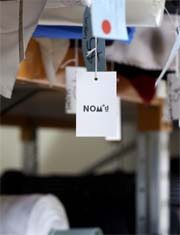
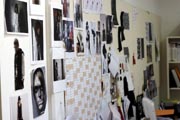
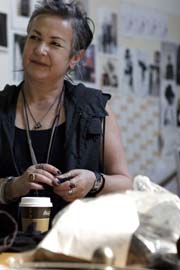
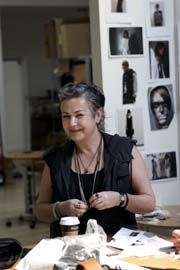
|

